Some people claim to have encountered fake reviews on Trustpilot.
However, the platform claims to be taking all possible measures to curtail it. So, what’s really true?
According to Trustpilot’s Transparency Report 2025, they have removed 4.5 million fake reviews in 2024 alone. This highlights just how big this problem has become.
But what does this mean for your business? And how can you protect your reputation without resorting to shady shortcuts?
In this blog, we’ll unpack Trustpilot’s review policies, dive into why fake reviews are so risky, and explore smarter ways to earn genuine customer trust. Plus, we’ll show you how tools like SocialPilot Reviews can help you manage authentic feedback the right way.
Understanding Trustpilot
Founded in 2007, Trustpilot is among the world’s largest online review platforms for e-commerce, SaaS, and service-based businesses.
The platform helps businesses build credibility by showcasing genuine customer feedback, empowering consumers to make informed decisions based on real user experiences.
With over 300 million reviews and 67 million active users every month, this platform racks up a staggering 127 billion brand impressions – and those numbers just keep going up.
Today, Trustpilot has become a go-to resource for both shoppers and businesses looking to establish trust.
With features like review invitations, sleek onsite widgets, Google Seller Ratings, and rich snippet stars, it helps businesses stand out in search.
Trustpilot’s Review Practices
Trustpilot’s review practices are designed to keep the platform open, transparent, and fair. Trustpilot’s review protocols aim to strike a balance between freedom of expression and protections against fake or harmful reviews.
What Trustpilot Allows
Let us now understand what the platform allows.
1. Open and Transparent Reviews
Trustpilot is a transparent review platform, which means anyone with a genuine experience – good or bad – can share a review without having to wait for an invitation.
However, reviews must follow Trustpilot’s guidelines, which means no hate speech, threats, or offensive content is allowed to be posted.
Additionally, Trustpilot’s policies clearly mention that businesses cannot force customers to write positive reviews or offer them incentives in exchange for good ratings, as this can lead to penalties.
Their approach is to capture a complete, honest picture of how a business treats its customers.
All reviews on Trustpilot are publicly visible, and the platform also uses advanced fraud detection software and manual checks to identify suspicious patterns or fraudulent activity.
2. Invited and Uninvited Reviews
To boost credibility, businesses can send automated review requests directly to customers after a purchase or interaction.
Businesses can share review generation forms or add a QR scanner to their feedback form. The purpose is to redirect customers to Trustpilot, allowing them to leave feedback.
This is what a review scanner typically looks like:
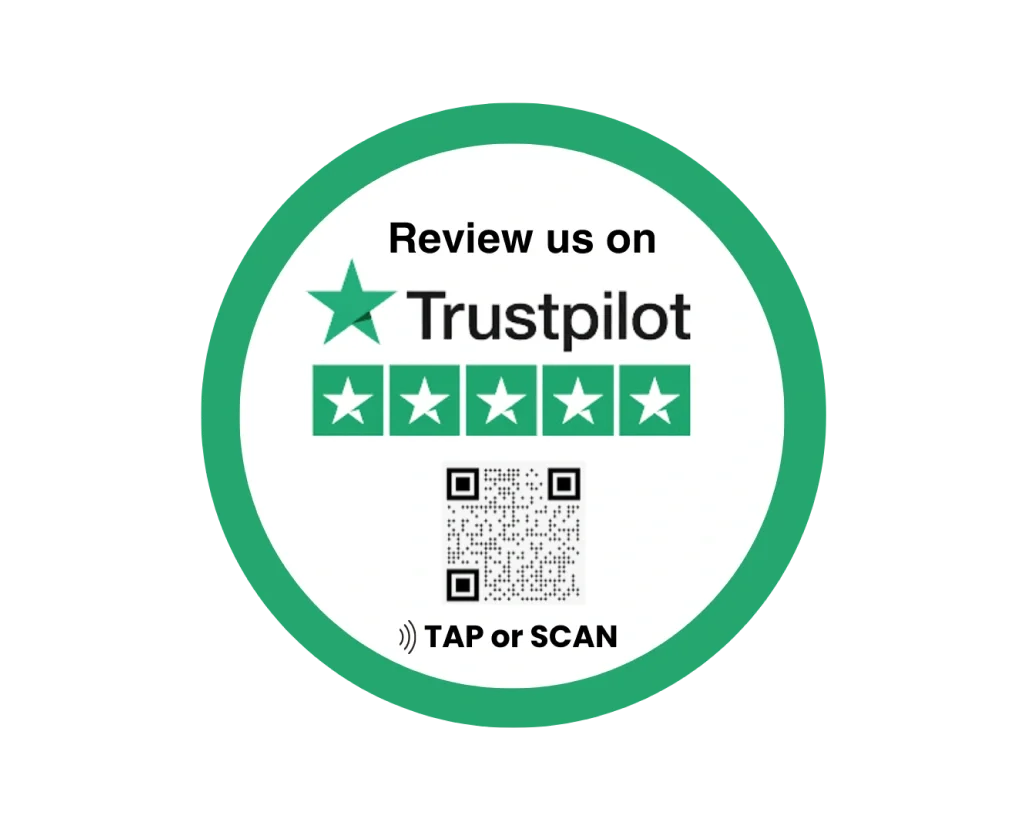
These invited reviews also help TrustPilot confirm that the reviewer is a real customer of the business and they’re linked to actual transactions (like order IDs or emails).
Meanwhile, this platform also allows uninvited reviews from those who didn’t get an invitation to do so.
So, how do they verify that their uninvited reviews are from real customers?
Trustpilot uses a couple of ways.
The platform first uses automated fraud detection technology to identify red flags, such as suspicious IP addresses, duplicate content, unusual posting patterns, or other data anomalies.
If a business disputes an uninvited review by flagging it, Trustpilot may reach out to the reviewer and request proof of their experience, such as receipts, order confirmations, or communication with the company.
In the absence of enough proof, a review might be taken down.
3. Business Responses and Engagement
Trustpilot supports both customers and businesses alike. Businesses are notified as soon as they receive feedback from one of their customers.
The platform also encourages businesses to reply to reviews if they’ve claimed their profile (a simple step that verifies their ownership) on Trustpilot. The graphic below shows how a claimed profile appears on Trustpilot.
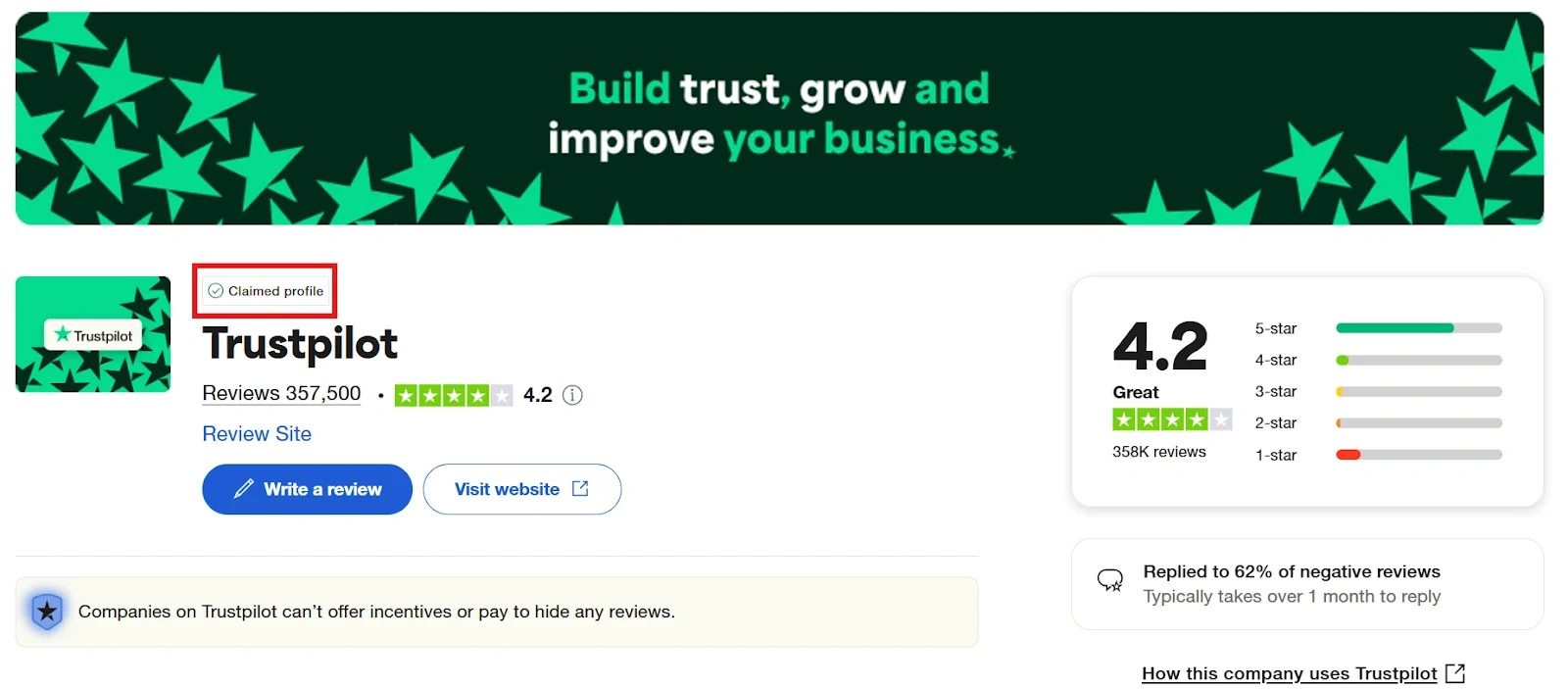
With a claimed profile, businesses can easily access all their customer reviews directly on their Trustpilot profile page.
Additionally, they can also reply to all their customer reviews – thank their happy customers, resolve complaints from unhappy ones, and also talk about their side of the story.
Responding to customer reviews is an excellent way for brands to demonstrate that they’re listening and genuinely care about customer feedback.
This open, two-way conversation between businesses and their customers is one of the key ways Trustpilot maintains transparency on its platform.
What Trustpilot Prohibits
While Trustpilot is all about open, honest feedback, there are clear lines businesses and reviewers can’t cross. Here’s what’s strictly off-limits:
1. Fake or Paid Reviews
Trustpilot has a zero-tolerance policy for fake reviews. This means writing or buying fraudulent reviews that don’t come from a genuine customer experience is strictly prohibited.
Trustpilot actively uses automated detection technology, wherein every review is analyzed before being posted online. It examines everything, from the review’s content to IP addresses, device details, and location data.
Their system checks for any unusual patterns that might indicate fake reviews, along with any content that breaks their guidelines, like promotional material, spam, or harmful and illegal content.
If they spot anything suspicious or find a breach of guidelines, the review gets flagged right away – so trying to game the system with fake positive feedback can backfire badly.
2. Review Gating and Filtering
Businesses aren’t allowed to screen customers or only invite happy ones to leave reviews – this practice, called review gating, skews ratings and misleads prospective customers.
Trustpilot requires businesses to send review invitations fairly, giving every customer, satisfied or not, a fair chance to share their experience.
The platform doesn’t allow businesses to remove critical reviews just because they don’t like them.
However, if you believe a review to be fake or against Trustpilot’s guidelines, you can flag it for review. This can be done by navigating to the reviews section of your business account, locating the review in question, and clicking the “Flag” icon next to it.
You’ll then need to select a reason for flagging.
Once done, simply wait for their decision, while their Content Integrity Team investigates the issue and decides whether to keep the review or remove it.
3. Incentivizing Reviews Without Disclosure
Offering discounts, freebies, or rewards in exchange for glowing reviews, without clearly disclosing it, is a big no-no.
Incentivized reviews, if any, must always be transparent; otherwise, they violate Trustpilot’s guidelines and can lead to removed reviews or penalties against the business.
So, what incentives are acceptable and what is prohibited?
Here’s what you can offer:
- Discounts or coupons for future purchases
- Small gifts or freebies (like a sample product)
- Loyalty points or similar rewards
Here’s what can’t be offered:
- Offering rewards only for leaving positive feedback
- Bribing customers to change or remove negative feedback
- Giving cash payments in exchange for reviews
- Conditional incentives (like those offered for only 5-star reviews)
Also, businesses must clearly communicate these incentives in their review invitation. One of the best ways of doing this is adding a short statement in the review invitation form, like:
“As a thank you, we’re offering a discount for leaving an honest review, positive or negative. We’ll share your feedback publicly on Trustpilot.”
By drawing these lines, Trustpilot aims to keep its platform fair and trustworthy for everyone, so customers get real insights through verified reviews, and businesses build credibility the right way.
What Some People Claim
While Trustpilot positions itself as an open and fair review platform, many business owners, reputation managers, and everyday users have voiced concerns about how reviews are moderated, flagged, or inflated.
Let’s break down what people are actually saying:
1. The Inconsistency of Moderation
Some users claim that Trustpilot’s moderation system for reviews doesn’t always seem even-handed, which means that genuine reviews are sometimes removed quickly, while suspicious or promotional reviews can stay up on Trustpilot accounts without any issue.
This has left some reviewers and business owners puzzled about how moderation decisions are made.
As shown in the image below, a Reddit user recently shared their frustration, stating that a negative review they submitted against a company was removed by Trustpilot, despite providing all the supporting documents.

Unfortunately, this is not just a single person’s experience; this Reddit thread highlights how several other Trustpilot users have had similar experiences with businesses worldwide. These people perceive moderation decisions on Trustpilot to be inconsistent or biased.
2. Unjustified Flagging of Reviews
Some users claim that honest reviews – especially when they are negative – are flagged and taken offline without providing any relevant information.
On Reddit, multiple commenters said they posted truthful but critical reviews, only to see them flagged and removed after businesses complained.
The image below is from one such reviewer who shared that after posting a balanced but critical review, the business disputed the authenticity of his review, which was ultimately taken down by Trustpilot.
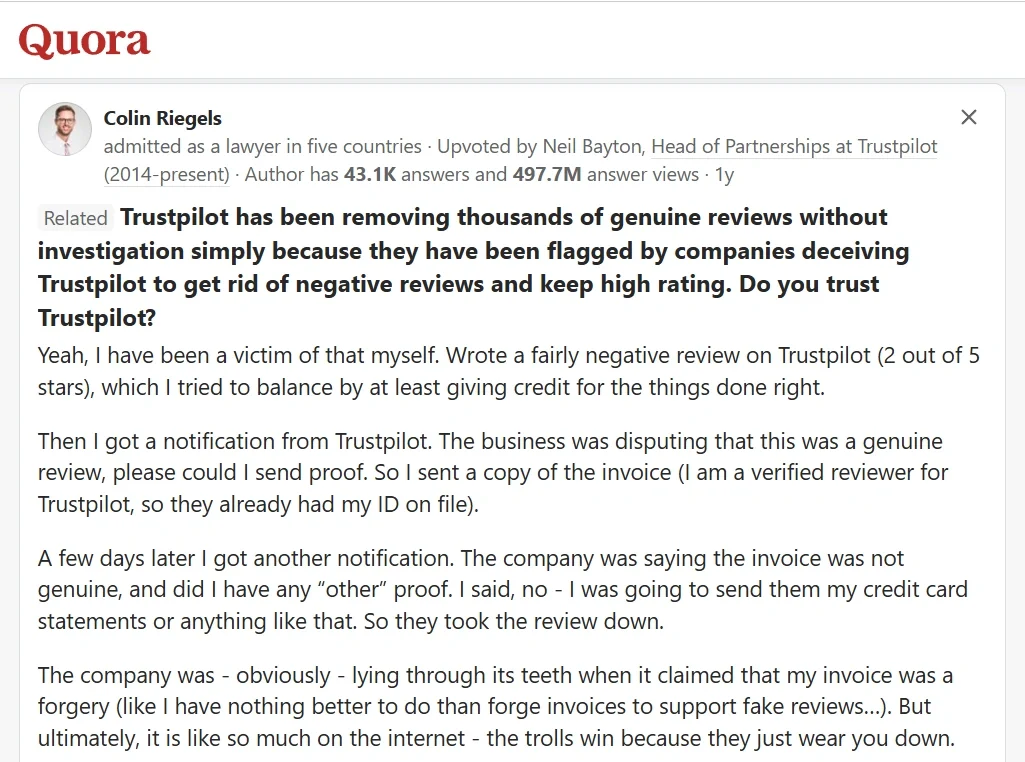
Even on Reddit, multiple commenters reported that they posted honest yet critical reviews, only to see them flagged and removed after businesses complained.
One user also accused the platform of being biased towards their top-tier clients, as shown in the image below.
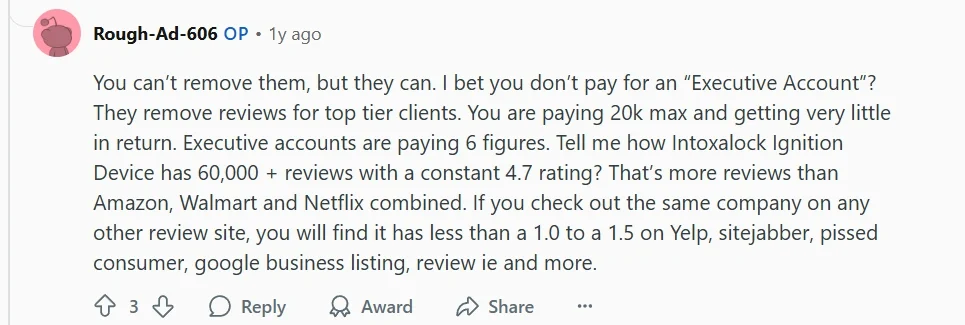
Such reviews rightfully create a perception that businesses, especially those paying for Trustpilot’s services, can more easily get unfavorable reviews removed, which might lead to skewed ratings.
3. Overly Inflated Positive Reviews
Several other users on Reddit and Quora have also talked about hundreds of near-identical 5-star reviews being posted for companies within a short period.
Some also argue that they have come across reviews that appear suspiciously coordinated, rather than reflecting genuine, individual experiences.
Such conversations have certainly raised some eyebrows.
Here is what one Reddit user says. The screenshot below sums up why some companies have overly inflated glowing reviews while others don’t.

4. Concerns About Pay-to-Play Models
Some businesses, particularly smaller ones, have also raised concerns over Trustpilot’s revenue model.
They claim that they feel pressured to subscribe to Trustpilot’s paid plans to display reviews prominently or manage negative feedback more effectively.
The following Reddit post discusses the common user perception that the platform works better for those who pay, potentially creating an imbalance in how businesses appear to their prospective customers on Trustpilot.

In discussions like these, some business owners claim that Trustpilot’s subscription fees – which start from $259/month – make smaller or newer companies feel disadvantaged compared to larger businesses with bigger budgets.
They believe that the platform’s pay-for-features approach is creating an uneven playing field, allowing companies with deeper pockets to gain better control.
While Trustpilot outlines clear review practices to promote transparency and fairness, there’s no denying that public sentiment around the platform is mixed.
We couldn’t independently verify the authenticity of these claims. However, any attempt to manipulate reviews, on any platform, can carry serious legal and ethical consequences, which we will talk about in the next section.
The smartest approach is to stay compliant, transparent, and focus on building credibility the right way. It’s not just safer – it’s sustainable.
Associated Risks and Ethical Concerns
If these Reddit and Quora threads are to be believed, there may be ways to buy positive reviews or bring down negative reviews on Trustpilot.
But the question is – is this practice worth it, and what could be the possible consequences?
Associated Risks
The points below will discuss the risks associated with buying reviews on Trustpilot:
- 1. Platform Penalties: Trustpilot can remove fake or manipulated reviews, suspend your ability to collect feedback, or publicly flag your profile, instantly damaging your online reputation.
- 2. Legal Trouble: Buying or selling fake reviews can violate consumer protection laws in many countries. Businesses caught engaging in deceptive practices may face hefty fines or lawsuits.
- 3. Loss of Credibility: Customers are smart and can spot patterns of suspiciously positive reviews. If they suspect you’re manipulating feedback, your brand’s credibility can tank overnight.
- 4. Google Penalties: Search engines like Google take review manipulation seriously. Review gating – inviting only happy customers to leave reviews – can violate Google’s guidelines and lead to ranking drops or removal of rich snippets.
- 5. Fake Reviews Don’t Drive Real Results: Even if you succeed in boosting your rating with fake reviews, they won’t bring you loyal customers or genuine referrals. Sustainable growth only comes from authentic, satisfied customers sharing honest feedback.
Ethical Concerns
Beyond the practical risks, buying or manipulating reviews raises serious ethical red flags:
- 1. Misleading Potential Customers: Fake reviews paint an inaccurate picture of your business, leading customers to make decisions based on false information.
- 2. Unfair Advantage Over Honest Competitors: When you guard your profile with fake praise, you’re tipping the scales against businesses working hard to earn the trust score, creating an uneven playing field.
- 3. Undermining the Review Ecosystem: Widespread review manipulation erodes trust in online reviews overall, making it harder for everyone – businesses and customers alike – to rely on honest experiences.
Why Companies Get Misled Into Buying Fake Trustpilot Reviews
Fake reviews might sound like something only shady businesses chase, but the truth is, even well-meaning companies can get pulled in by promises of quick wins.
In the sections below, we’ll break down the common traps that lure companies into risky shortcuts – and why these supposed “solutions” only lead to bigger problems down the line.
The False Promise of a Polished Brand Image
Buying fake reviews might seem like a shortcut to a glowing online reputation, but it’s only a facade, and one that can crumble fast.
In 2023, the FTC fined Roomster and its owners $1.6 million for flooding their apartment rental platform with fake five-star reviews to boost credibility. Here’s what the report said:
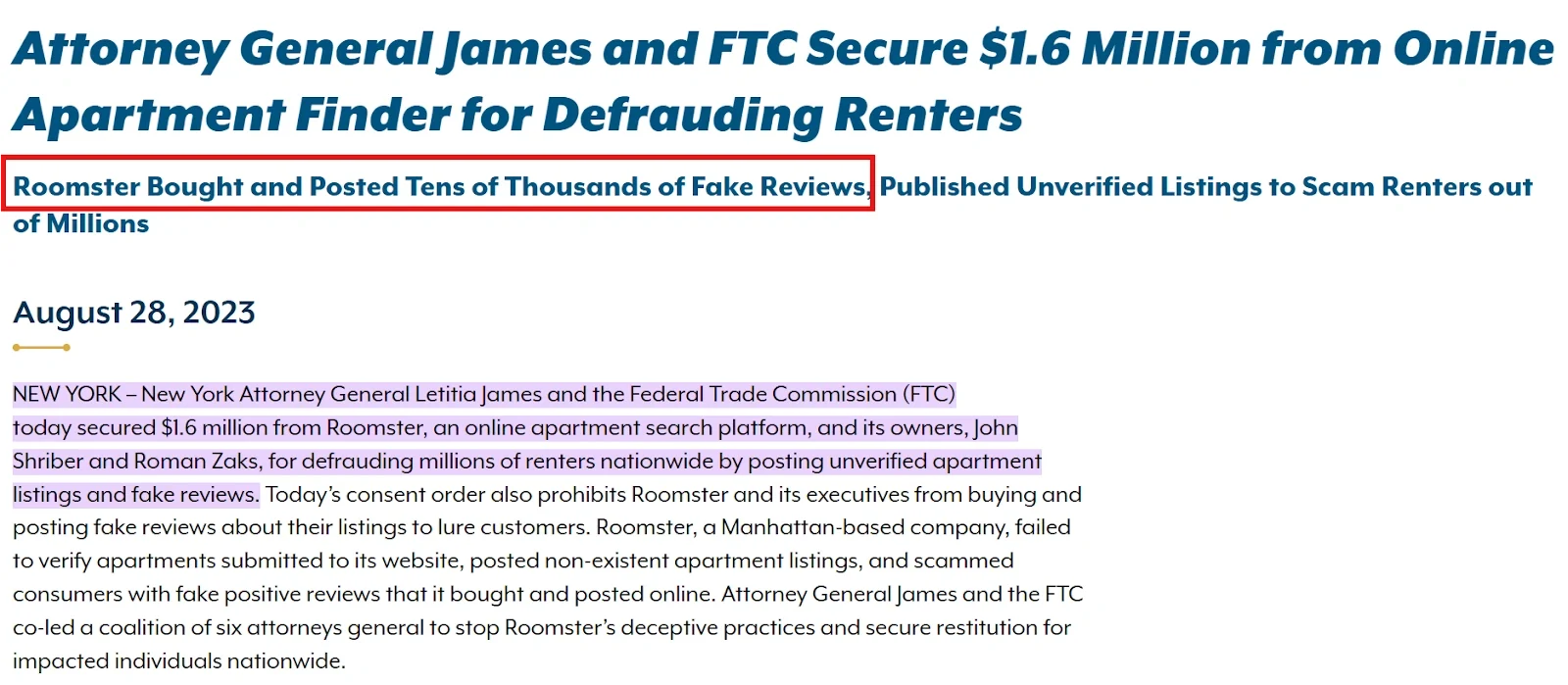
When exposed, the polished image they built evaporated overnight, leaving lasting damage to their brand.
The Illusion of Instant Credibility
Some businesses think that getting fake praise will instantly make them look trustworthy.
But that’s not always a smart thing to do. In January this year, the U.S. Federal Trade Commission (FTC) fined online retailer Fashion Nova $2.4 million for suppressing negative feedback on its website – one of the first major enforcement actions against deceptive review practices.
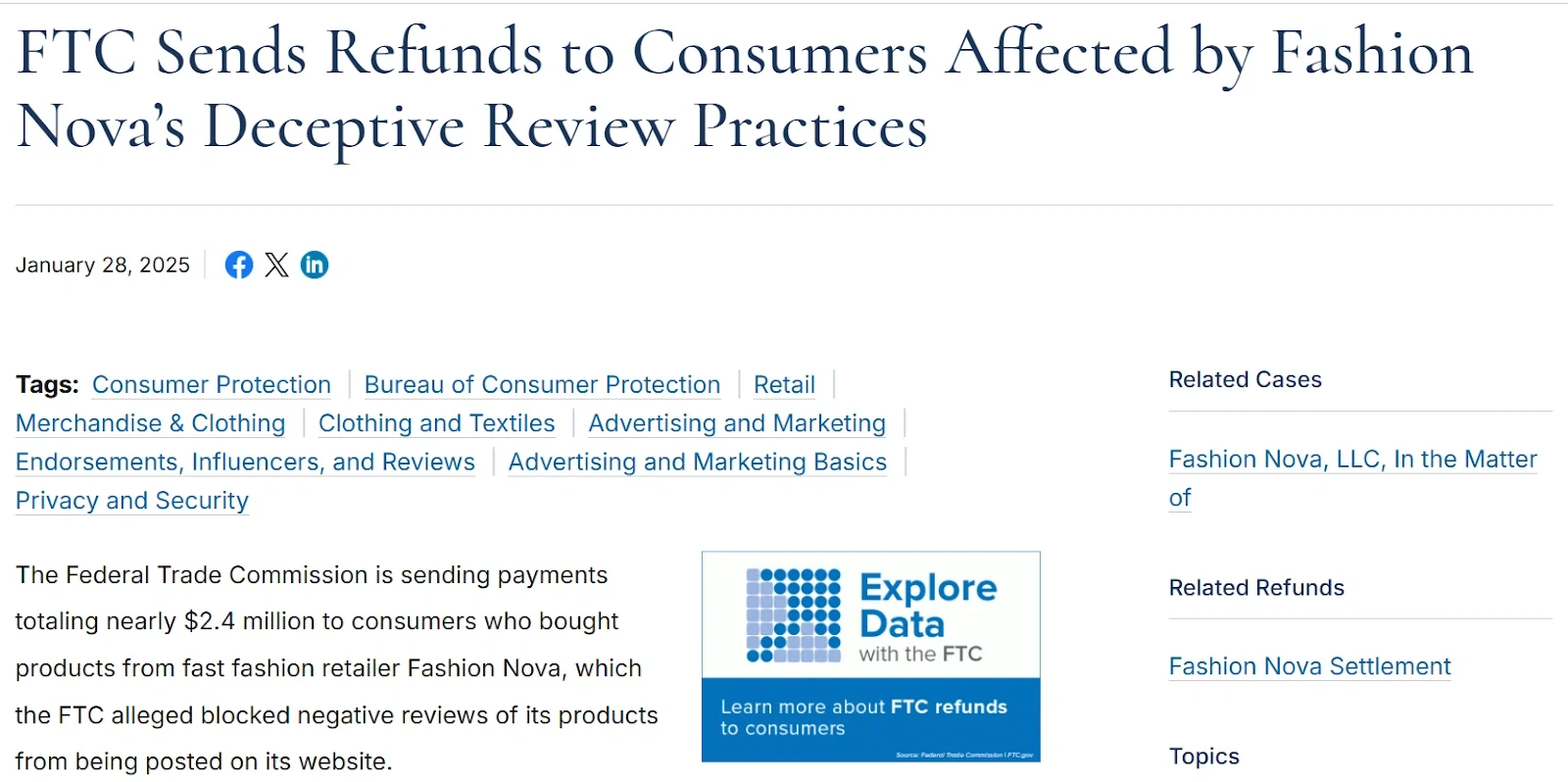
This tells us that real credibility needs to be built, and it can’t be bought.
The Myth of Higher Conversions Through Fake Feedback
It’s tempting to believe that fake positive reviews will boost your sales overnight, but misleading potential customers can backfire spectacularly.
Back in 2013, New York’s Attorney General ran “Operation Clean Turf,” an undercover sting that revealed businesses buying fake Yelp and Google reviews. The investigation led to 19 companies being fined a combined $350,000 for posting fake online reviews.
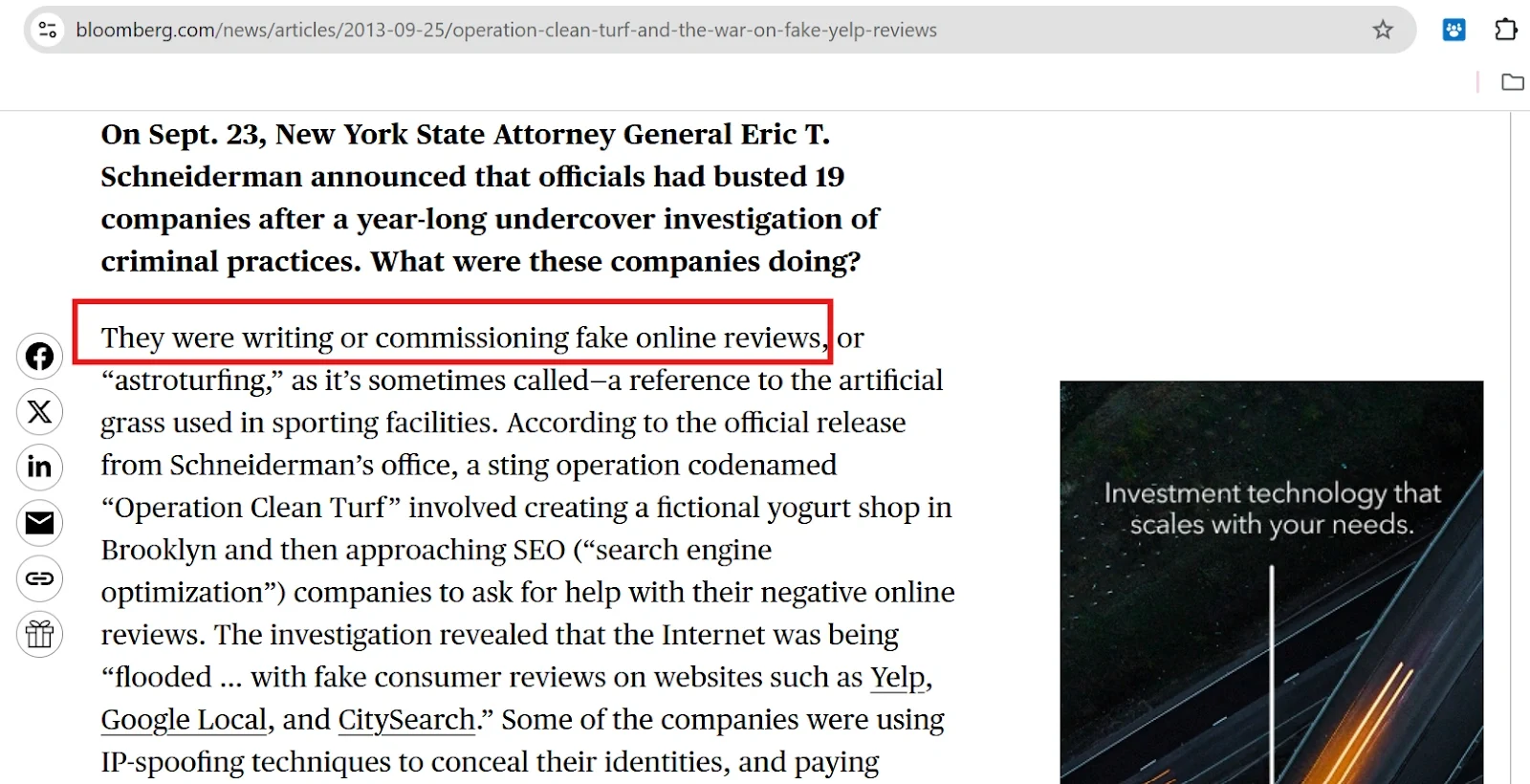
This landmark case helped shape stricter enforcement of deceptive marketing.
The Deceptive Promise of Better SEO and Visibility
Some services claim fake reviews will shoot you up in search rankings. However, in reality, Google’s algorithms and savvy customers can quickly catch such deceptive practices.
Sunday Riley, a US skincare brand, was caught ordering employees to post fake reviews on Sephora’s website. The FTC charged them with deceptive practices, and the brand’s reputation took a major hit.

The truth is that fake feedback doesn’t bring real customers; it brings scandal, lost trust, and long-term damage.
The Desperate Move of Burying Bad Reviews Under Fakes
When faced with a wave of negative feedback, some businesses try to hide it under piles of fake positives. But this only deepens mistrust once uncovered.
Also, as the FTC’s crackdown on deceptive review practices shows, this tactic can cost you far more in fines and lost trust than simply addressing the real issues and earning genuine praise.
What to Do Instead?
Now we know that buying fake reviews isn’t just unethical, but it can also land you in serious legal hot water and destroy your brand’s credibility.
So, what can businesses do to build long-term brand credibility the right way? Here’s where to start:
1. Encourage Genuine Reviews
Authentic reviews are the backbone of real credibility. They don’t just boost your star ratings – they also help build customer trust in you. Genuine feedback also offers you some real insights to help you improve.
Unlike fake reviews, authentic feedback establishes a lasting online reputation that can’t be undermined by an FTC investigation or a wave of negative publicity.
How to do it:
- Ask every customer for feedback, not just the satisfied ones.
- Send review requests quickly after a purchase or service, to increase your chances of getting feedback.
- Include direct links to your Trustpilot profile to make leaving reviews effortless.
- Use polite, personalized messages instead of generic ones to make your customers feel valued.
- Remind customers that honest reviews – good or bad – help you improve and serve them better.
Let SocialPilot Reviews streamline the review generation process for you.
This tool helps you send automated review requests to your customers via email or SMS in a tone that aligns with your brand voice.
Additionally, its centralized dashboard allows you to monitor, manage, and interact with all your reviews in a timely manner.
SocialPilot Reviews not only saves your time but also boosts your chances of receiving authentic reviews from real customers, helping you build a credible reputation without shortcuts.
2. Address Negative Feedback
Negative reviews can be hard to process, but ignoring them is a missed opportunity. Responding to negative reviews shows your customers (or prospects) that you take their feedback seriously and are committed to fixing issues.
How to do it:
- Stay calm and professional, and never ever argue or get defensive.
- Acknowledge the customer’s experience and apologize if needed.
- Offer to resolve the issue offline to show you care about making it right.
- Follow up publicly to share the resolution – this helps build your public image by demonstrating that you took the complaint seriously
3. Focus on Customer Service
Offering excellent customer service is a sure-shot way to getting glowing reviews. When customers feel cared for and heard, they’re naturally more inclined to share positive experiences without needing any incentives.
How to do it:
- Train your team to listen actively and empathize with customer concerns.
- Set clear standards for response times and ensure customers aren’t left waiting.
- Empower employees to resolve common problems on the spot.
- Collect and analyze recurring complaints to fix root causes, not just symptoms.
4. Proactively Solicit Feedback
Don’t wait for reviews to come to you randomly – ask for them! Proactively seeking feedback will not just bring you more reviews but will also show your customers that you care about their opinions.
- Build review requests into your workflows (e.g., after delivery emails or post-service calls).
- Use simple, direct CTAs like “We’d love to hear how we did – leave us a review!”
- Remind loyal customers to leave reviews by adding requests in newsletters or follow-up messages.
- Regularly analyze collected feedback to identify areas for improvement.
Tools That Help Generate Authentic Trustpilot Reviews
We know that fetching reviews the right way takes time, but it’s time well spent.
Authentic feedback helps build unbreakable trust and long-lasting credibility for your business. And in a world where shortcuts can backfire spectacularly, a steady stream of honest reviews is worth the wait.
The good news is that by using review generation tools, you can not just streamline this process, but also make it quicker.
Let us now talk about some such tools:
SocialPilot Reviews makes review management easy and scalable. You can automate review requests, monitor responses, and engage with customers across multiple review generation platforms – all from one user-friendly dashboard.
The best part is that its pricing plans start as low as $25.5/month, making it an affordable choice for small and growing businesses.
With SocialPilot Reviews, you can also manage reviews for all your business locations in one place.
Additionally, it comes with an AI-powered review response feature and CRM integration to manage all reviews smoothly. Overall, it is ideal for businesses and agencies of all sizes, whether they are just starting out or already managing reviews for a multi-location business.
Start your free trial today and experience seamless review management.
2. Birdeye
Birdeye specializes in multi-platform review management, featuring tools such as SMS and email review requests, AI-powered response suggestions, and in-depth analytics to identify trends in customer sentiment.
The pricing plan for Birdeye starts at $299/month, which can be a bit steep for small businesses.
However, this review platform works best for large teams seeking an excellent analytics dashboard that also supports video and photo reviews. Some first-time users may find the platform complex and overwhelming.
3. Podium
Podium focuses on customer interaction through text messaging, making it easy for businesses to send SMS review requests, collect payments, and even engage in chat conversations with customers, all on one platform.
It also integrates with popular payment tools and CRM systems, allowing businesses to offer a seamless experience for their customers while boosting engagement.
Pricing plans for Podium start from $399/month, and the platform works great for multi-location brands and local businesses in North America.
The Final Word
At the end of the day, buying fake Trustpilot reviews isn’t just risky – it is a sure shot way to destroy your credibility, invite legal trouble, and leave your business in worse shape than when you started.
The truth is that no business should resort to shady tactics to build a stellar reputation.
Businesses must instead focus on offering great customer service, addressing feedback head-on, and encouraging honest reviews, so they can earn trust the right way.
Review generation and management tools like SocialPilot Reviews can help you streamline this entire process at a much affordable price point.
Sign up for the free trial of SocialPilot Reviews and start collecting authentic reviews to build long-term brand credibility.
Skip the fakes, stick to the facts, and watch your reputation thrive.



